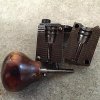OS OK
New Member
I have cast lots of different style boolits but have never, until this past couple of week tried to cast a hollow point and make it work downrange.
For the first attempt, I wanted to try to get a low velocity, low pressure cast that would work in a .45 ACP. I'd like to have a round for self defense that wouldn't go through a perp and then through a couple of sheetrock walls and harm anyone else, just the 'bad guy'. I have loaded the J-types and have had poor success even when speeding them up to near max which can be hard on a semi-auto, jacketed low vel/pres. HP's just don't compare to the power of a magnum hollow points expansion.
As a caster, I should be capable of making a cast that will mushroom under whatever speed or pressure the weapon is capable of shooting.
I lucked into an old single cavity Lyman 452 423 SWC-HP and found that regular diluted COWW's were too hard, even when mixed down 50%.

But...after changing the Pb to a softer than usually used for the pressure involved and...thinking of the PC coating as a 'more than just a substitute for lubrication' and realizing it is a 'jacket of sorts'...I got this...measuring OD @ .816"...and keeping full weight.

For these...I used straight SOWW's (stick on wheel weights) with nothing else added, not even Sn.
The BHN after casting and Powder Coating was 7.4 . The mold is a 230 grain design but with this lead they came out @ 238 & 239 grains. I sized them @ .451" . Not oversized...thinking jacketed by the PC.
I powder coated them with Black gloss by tumbling coating in a tub.
The powder was 700-X @ 4.8 grains and the avg. velocity was 863 FPS ... pretty slow huh?
I filled a 4" PVC pipe with water and shot this one down the 10' length and the pressure caused the duct taped end to blow off but it didn't let the cast get damaged.

The red marks a lot on the boolit makes it easier to measure the indent when using the Lee BHN measuring scope.
Next I'll try a .38/357 SWC-HP mold, Lyman 358 439 and try to get a regular .38 Special @ typical velocity and pressure to do the same thing.

We'll see...
Thanks for taking the time to read my first post here...I'm passionate about this hobby and spend lot's of time at it...whenever the 'honey-doos' permit that is.
If you would like to add on here with your efforts and results...have at it and welcome.
charlie
For the first attempt, I wanted to try to get a low velocity, low pressure cast that would work in a .45 ACP. I'd like to have a round for self defense that wouldn't go through a perp and then through a couple of sheetrock walls and harm anyone else, just the 'bad guy'. I have loaded the J-types and have had poor success even when speeding them up to near max which can be hard on a semi-auto, jacketed low vel/pres. HP's just don't compare to the power of a magnum hollow points expansion.
As a caster, I should be capable of making a cast that will mushroom under whatever speed or pressure the weapon is capable of shooting.
I lucked into an old single cavity Lyman 452 423 SWC-HP and found that regular diluted COWW's were too hard, even when mixed down 50%.

But...after changing the Pb to a softer than usually used for the pressure involved and...thinking of the PC coating as a 'more than just a substitute for lubrication' and realizing it is a 'jacket of sorts'...I got this...measuring OD @ .816"...and keeping full weight.

For these...I used straight SOWW's (stick on wheel weights) with nothing else added, not even Sn.
The BHN after casting and Powder Coating was 7.4 . The mold is a 230 grain design but with this lead they came out @ 238 & 239 grains. I sized them @ .451" . Not oversized...thinking jacketed by the PC.
I powder coated them with Black gloss by tumbling coating in a tub.
The powder was 700-X @ 4.8 grains and the avg. velocity was 863 FPS ... pretty slow huh?
I filled a 4" PVC pipe with water and shot this one down the 10' length and the pressure caused the duct taped end to blow off but it didn't let the cast get damaged.

The red marks a lot on the boolit makes it easier to measure the indent when using the Lee BHN measuring scope.
Next I'll try a .38/357 SWC-HP mold, Lyman 358 439 and try to get a regular .38 Special @ typical velocity and pressure to do the same thing.

We'll see...
Thanks for taking the time to read my first post here...I'm passionate about this hobby and spend lot's of time at it...whenever the 'honey-doos' permit that is.
If you would like to add on here with your efforts and results...have at it and welcome.
charlie




